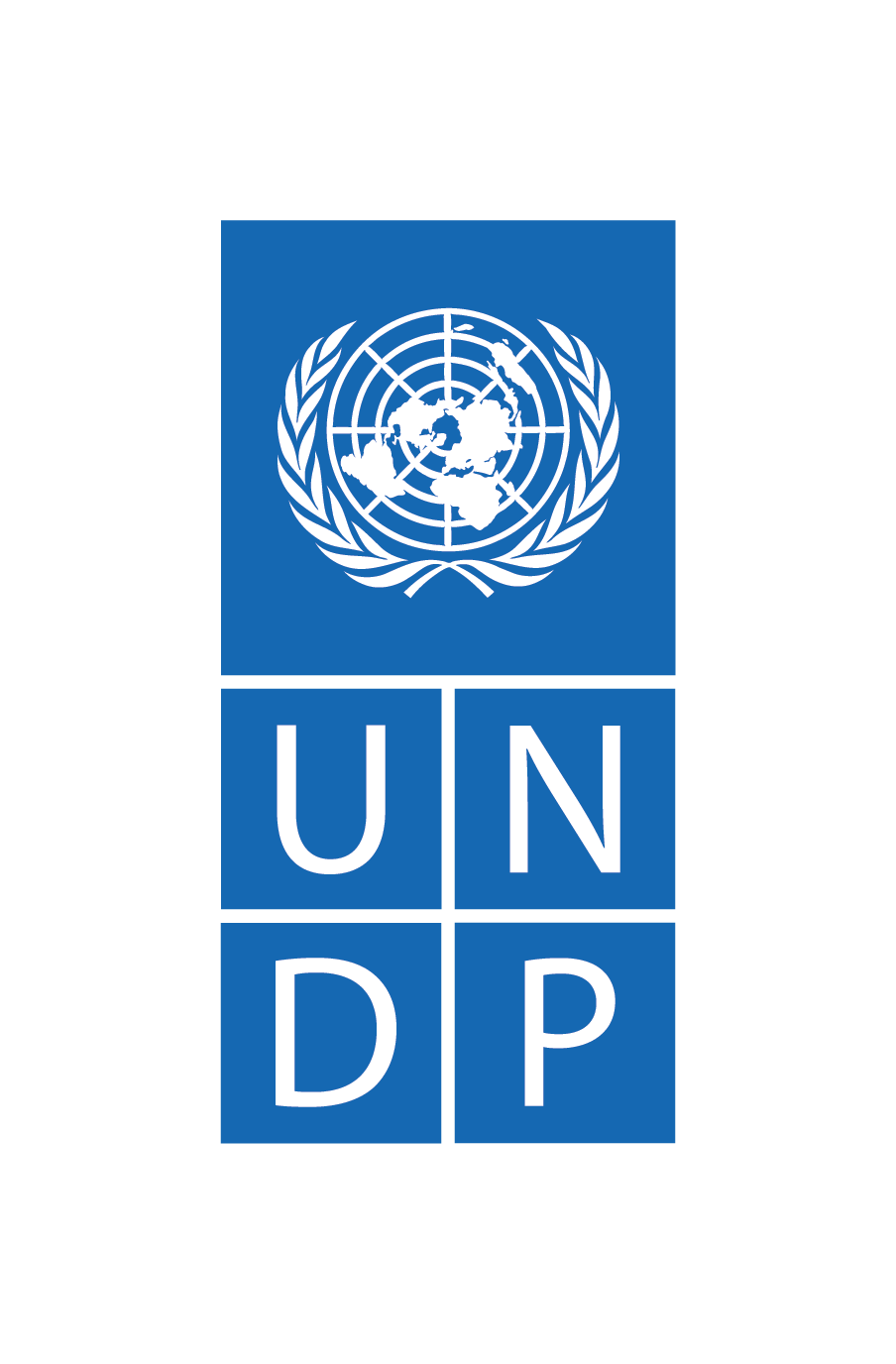Drafting the capacity development plan
Purpose
Based on the capacity assessment report, a capacity development plan can be drafted. The plan defines a set of prioritized objectives and activities to address the capacity needs identified through the assessment. It includes a clear and practical timeline, measurable indicators, and a realistic budget to implement change and measure progress.UNDP’s approach
Once the needs of a programme and all relevant stakeholders are identified through the capacity assessment, UNDP supports the identification of capacity development activities and the development of baselines and targets to form the basis of the capacity development plan.
- Identify interventions: the activities should be described in detail, noting the capacity strengths and weaknesses that have led to the proposed activity.
- Define capacity development indicators: each capacity development activity should have a clear indicator to measure progress. Indicators should be relevant and feasible to measure.
- Outline capacity development objectives: the plan should outline the overall objectives of groups of activities. For example, activities such as developing financial policies and procedures and training staff to effectively implement these procedures would contribute to the overall objective of strengthening financial management capacities and reducing risk. Similarly, investing in renovating storage facilities at health clinics and designing and implementing an electronic logistics management information system would contribute to the objectives of improving the supply of health products and reducing wastage.
- Develop an estimated budget: Once the activities are agreed, the budget should be developed using standard costing.
Tools and guidance
UNDP has developed templates for a wide variety of capacity development plans, including for civil society organizations (CSOs), national AIDS councils, ministries of health and programmes targeting specific key populations working in HIV, which can be found below.
The following points should be considered when completing the capacity development plan:
- Define appropriate indicators: defining indicators to measure changes in capacity is difficult, but they are key to measuring success. The number of indicators should be as few as possible, easily measurable, and SMART (specific, measurable, achievable, realistic and time-bound), and should consider both qualitative and quantitative progress where possible.
- Identify short-term objectives: to build confidence and experience and to demonstrate results and value, it is important to schedule and plan for some short-term objectives in the capacity development plan (typically within one year). These objectives can help to guide follow-on interventions.
- Aim to set long-term objectives: capacity development is a process of change, often involving multiple activities. There is a need for capacity development to be more explicitly woven into national programme management processes. In the long-term, clear objectives and milestones should be embedded into national health programmes.
- Coordinate with existing strategies and plans: capacity development plans should not stand alone but should be integrated into existing national strategies and plans.
Capacity development planning with Global Fund support
The Global Fund will invest in interventions that support national strategic plans and promote alignment with programme activities. The capacity development plan can include interventions to strengthen the development of disease-specific national strategic plans and the establishment of strong links with national health strategies. Where possible, planning for a programme transition to a national entity should be done at the same time as capacity development planning, to define the desired capacity in each area, and to set measurable milestones for the transfer of responsibilities.
Interventions eligible for the Global Fund support include:
- Activities that contribute to planning, developing and reviewing national health sector strategies, health systems-related strategies and sub-strategies (e.g., HRH or procurement and supply chain systems);
- Developing and supporting mechanisms to supervise, monitor and report on the implementation of health sector and disease-specific laws and policies;
- Activities that contribute to financing of these plans;
- Activities at the local, district, regional and national levels aimed at integrated planning, programming, budgeting and financings;
- HRH-related costs, such as capacity-building for policymakers.
Suggested capacity development indicators include: Existence of an up-to-date national health strategy, linked to national needs and priorities; Evidence of mid-term strategy review and updates, and final evaluation; Strategy has a supporting operational plan and is fully costed.
Key resources
Note that most of the tools shared on the page “Conducting the capacity assessment” are the same as those for preparing the capacity development plan. They are included again below.
Capacity development for national entities implementing the Global Fund Grants:

Capacity Assessment and Planning Tool – National PRs of the Global Fund Grants
This comprehensive tool is designed for HIV, tuberculosis and malaria with the main purpose of strengthening the systems and procedures of national entities to manage national programmes.
MS Excel
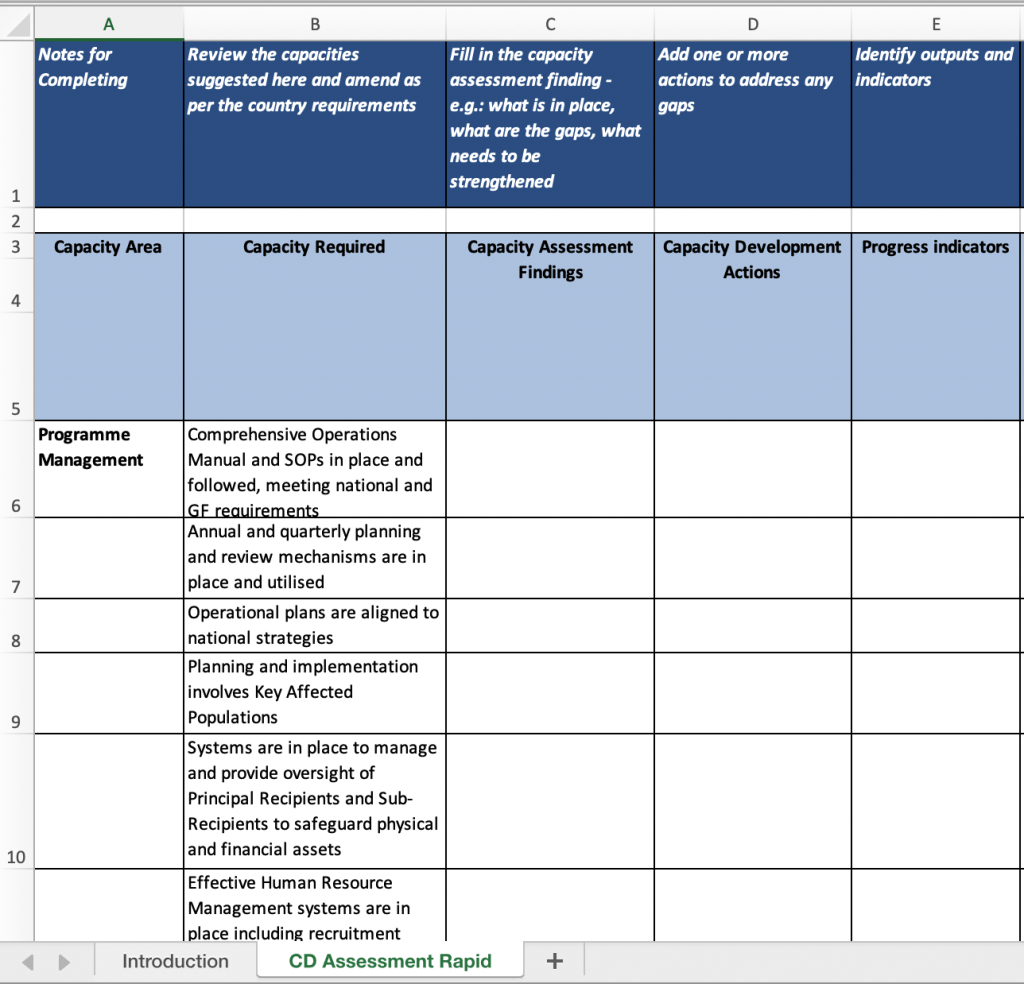
Rapid Capacity Assessment and Planning Tool – National PRs of the Global Fund Grants
This rapid tool is designed for HIV, tuberculosis and malaria with the main purpose of strengthening the systems and procedures of national entities to manage national programmes.
MS Excel
Capacity Development for Other Implementers:
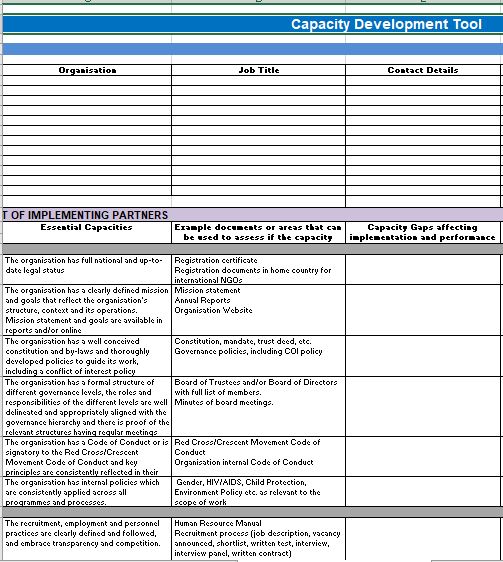
Civil Society Organization Capacity Assessment and Development Tool
This tool is to support the capacity assessment and development of CSOs, covering programme management, monitoring and evaluation, financial management and procurement.
MS Excel

Capacity Assessment Tool – the Global Fund Regional Grants
The plan outlines and prioritizes capacity development objectives, interventions and output indicators designed to enhance implementers’ capacity in multiple countries.
MS Excel
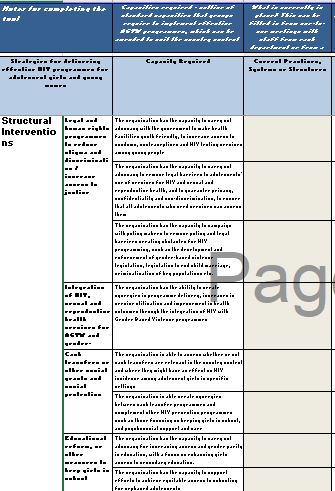
Capacity Development Assessment Tool Template – HIV Prevention for Adolescent Girls and Young Women
A tool to assess the capacity of organizations to develop and implement HIV prevention programmes focusing on adolescent girls and young women.
MS Excel
Tools for transitioning the Global Fund PR role:
Where possible, planning for a programme transition to a national entity should be done at the same time as capacity development planning, to define the desired capacity in each area and to set measurable milestones for the transfer of responsibilities. Refer to the section on transition section for more guidance.

Capacity Assessment for Transition Planning Tool – the Global Fund Grants
The tool is designed for assessing the capacity of potential PRs and to detail activities that need to take place before the transition to a new Global Fund PR can fully occur.
MS Excel

Transition & Systems Development Plan Template for the Global Fund Grants
This tool details milestones and activities that need to take place before the transition to a new Global Fund PR can fully occur.
MS Excel

Transition Milestones Examples
The transition milestones were developed to measure the successful implementation of the transition of the PR to national entities.
MS Word
Terms of References Templates:
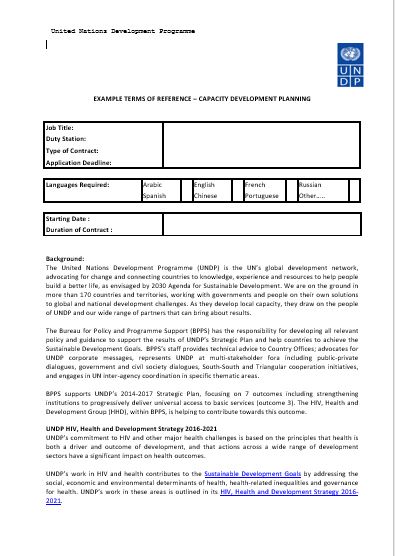
Generic TOR CD planning
Example document and template for writing terms of reference for capacity development planning.
MS Word

Generic TOR CD and transition planning
Example document and template for writing terms of reference for capacity development and transition planning.
MS Word
Resources for Strengthening National strategic Plans:

Joint Assessment of National Health Strategies (JANS)
These tools and guidelines provide a shared approach to assess the strengths and weaknesses of a national health strategy or plan. JANS can support the assessment of what is required to develop resilient and sustainable health systems.
PDF
